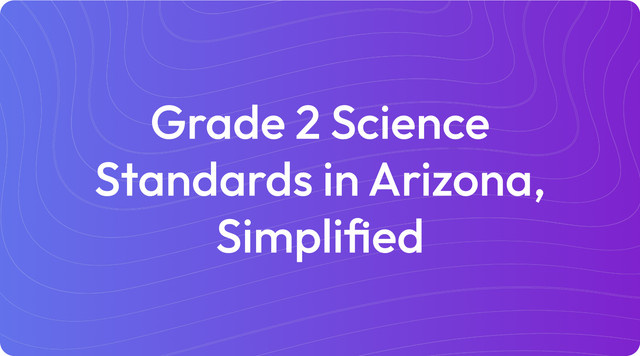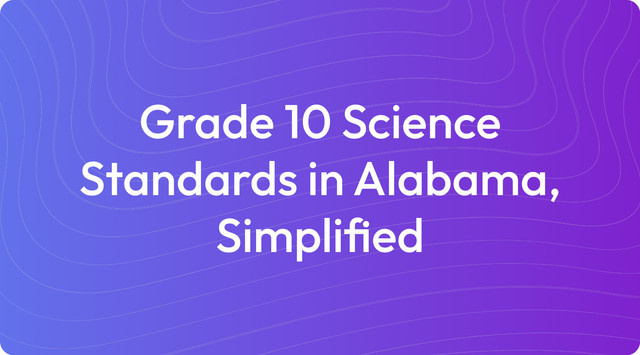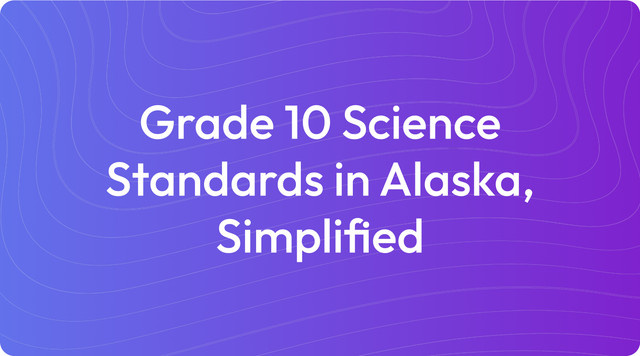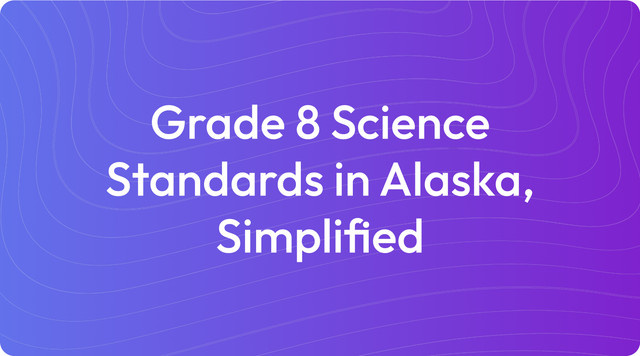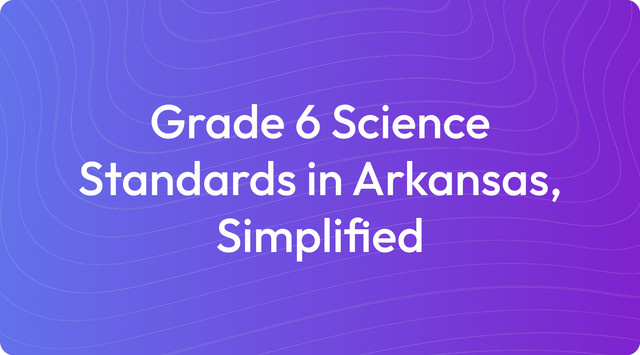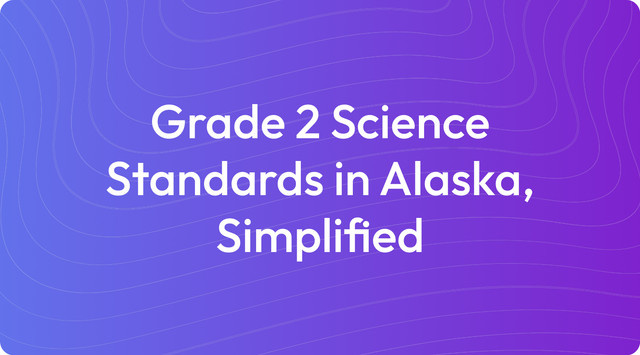Grade 5 Science Standards in Alabama, Simplified
Grade 5 science covers matter, energy, ecosystems, and Earth's systems in Alabama. See what’s included—read more on TeachShare!
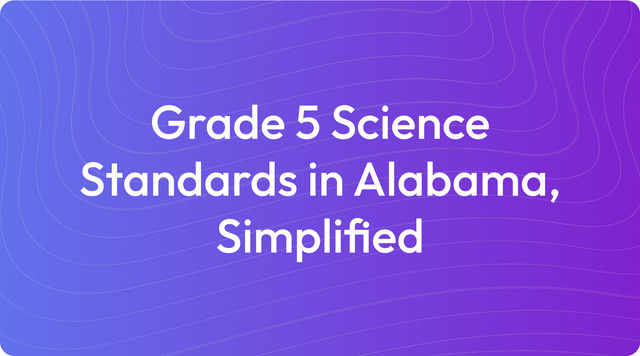
We understand that working with education standards is a core part of your planning. These standards guide curriculum, but translating them into daily classroom activities can present challenges. Our aim is to offer resources that help you connect these learning goals to your lesson plans, making the process more direct for you and your students.
Education standards are learning goals that outline what students should know and be able to do by the end of a grade. For teachers, they provide a clear framework for instruction without dictating specific teaching methods. For instance, the Grade 5 Science Standards in Alabama require students to model particles of matter, leaving you the professional autonomy to design the specific activity, such as modeling how water particles behave when changing states.
What Are Grade 5 Science Standards in Alabama?
The Grade 5 Science Standards in Alabama are organized into four key areas, focusing on building a foundational understanding of core scientific principles. Here is a breakdown of the standards and the core concepts your students will explore in each area:
Physical Science (PS): Matter and Energy
Standard 1: Develop models to describe the particles that make up matter and how they combine to form new substances (e.g., solids, liquids, gases).
Standard 2: Investigate and explain the conservation of matter during physical and chemical changes.
Standard 3: Conduct experiments to identify materials based on their physical and chemical properties.
Earth and Space Science (ESS): Earth’s Systems and Space
Standard 4: Explain how the geosphere, biosphere, hydrosphere, and atmosphere interact in Earth’s systems.
Standard 5: Interpret data to describe patterns in the movement of celestial bodies (e.g., stars, planets, moons).
Standard 6: Use models to explain how the Sun’s energy drives the water cycle.
Life Science (LS): Organisms and Ecosystems
Standard 7: Develop models to describe how matter and energy flow through ecosystems (e.g., food webs, decomposition).
Standard 8: Analyze and interpret data to explain how plants use air, water, and sunlight to produce food and grow.
Engineering, Technology, and Applications of Science (ETS): Problem-Solving
Standard 9: Design and test solutions to monitor or minimize human impact on Earth’s systems (e.g., water usage, pollution, habitat loss).
The framework for these standards is guided by the Alabama Course of Study: Science (2015).
Key Tested Standards
For teachers, knowing which standards are prioritized on assessments is crucial for effective lesson planning. The Grade 5 Science Standards emphasize critical concepts across Physical Science, Life Science, Earth and Space Science, and Engineering Design. The key tested standards focus on assessing a student's ability to conduct investigations, analyze data, and solve real-world problems.
Key Tested Standards for Grade 5 Science in Alabama
1. Physical Science (PS): Matter and Energy
Standard 1: Develop models to describe the particles that make up matter and how they combine to form substances.
Why It’s Key: This standard helps students understand the structure of matter and how it changes states (solid, liquid, gas).
Standard 2: Investigate and explain the conservation of matter during physical and chemical changes.
Why It’s Key: Students learn that matter is not created or destroyed during changes, building foundational knowledge for chemistry concepts.
Standard 3: Conduct experiments to identify materials based on their physical and chemical properties.
Why It’s Key: Students practice observation, classification, and experimentation to identify materials by properties like magnetism, solubility, and conductivity.
2. Earth and Space Science (ESS): Earth’s Systems and Space
Standard 4: Explain how the geosphere, biosphere, hydrosphere, and atmosphere interact in Earth’s systems.
Why It’s Key: This standard helps students understand Earth as a system made up of interconnected parts and how changes in one sphere affect others.
Standard 5: Interpret data to describe patterns in the movement of celestial bodies (e.g., stars, planets, moons).
Why It’s Key: Students analyze patterns like Moon phases, orbits, and seasonal changes to understand Earth's place in space.
Standard 6: Use models to explain how the Sun’s energy drives the water cycle.
Why It’s Key: Students explore the connection between the Sun and processes like evaporation, condensation, and precipitation.
3. Life Science (LS): Ecosystems and Energy Flow
Standard 7: Develop models to describe how matter and energy flow through ecosystems (e.g., food webs, decomposition).
Why It’s Key: Students learn how energy transfers between organisms and the importance of producers, consumers, and decomposers in ecosystems.
Standard 8: Analyze and interpret data to explain how plants use air, water, and sunlight to produce food and grow.
Why It’s Key: Students explore photosynthesis and the role of plants in providing energy to the entire food chain.
4. Engineering, Technology, and Applications of Science (ETS): Problem-Solving
Standard 9: Design and test solutions to monitor or minimize human impact on Earth’s systems (e.g., water usage, pollution, habitat loss).
Why It’s Key: Students apply science and engineering practices to solve real-world problems like conserving resources or reducing pollution.
Why These Standards Are Key for Testing
These standards are prioritized because they assess students' ability to:
Analyze Data: For example, interpreting data related to Moon phases, chemical changes, or plant growth.
Develop and Use Models: For example, creating models of the water cycle, food webs, or Earth’s systems.
Conduct Investigations: For example, testing properties of materials or observing conservation of matter during chemical reactions.
Solve Problems: Designing solutions to real-world challenges, such as reducing human impact on ecosystems.
Sources: Alabama State Department of Education, Next Generation Science Standards.
Example Learning Objectives for Unit Planning
Learning objectives are clear, specific statements that describe what students should be able to do by the end of a lesson. They break down broader state standards into actionable, daily goals for your classroom. These objectives help you design focused activities and measure student progress effectively.
Standard 7: Matter and Energy Flow in Ecosystems
Here are a few examples of learning objectives for this standard, written as student-friendly “I can” statements:
I can explain how energy moves from the Sun to plants and then to animals.
I can create a food web that shows the connections between producers, consumers, and decomposers.
I can describe how decomposers recycle nutrients by breaking down dead organisms.
I can predict how an ecosystem might change if one organism is removed.
Standard 6: The Sun and the Water Cycle
Similarly, for this standard, you can frame the learning goals for your students like this:
I can name and describe the stages of the water cycle: evaporation, condensation, precipitation, and collection.
I can explain that the Sun’s energy is what drives the water cycle.
I can draw a model showing how water moves through the atmosphere, land, and oceans.
I can connect the water cycle to local weather and environmental conditions.
Key Changes & Updates
The Grade 5 Science Standards, based on the Alabama Course of Study: Science (2015), introduced important updates to classroom instruction. The framework shifts learning toward more hands-on, inquiry-based activities, where you can guide students through investigations and model-building. This approach is grounded in making science relevant by connecting concepts directly to real-world phenomena, such as the water cycle's effect on weather. A key update is the integration of engineering practices, which challenges students to apply their knowledge by designing and testing solutions to practical problems, like minimizing human impact on the environment.
Beyond these instructional shifts, the standards also place a greater focus on developing specific cognitive skills. There is a new emphasis on systems thinking, helping students understand how different components—like the geosphere, hydrosphere, and biosphere—interact. Students are now expected to develop evidence-based explanations, using data they collect to support their conclusions about scientific principles like the conservation of matter. These standards also intentionally incorporate cross-disciplinary skills, linking science with math for data analysis and literacy for communicating findings, all while fostering a greater sense of environmental awareness.
Create with TeachShare
We understand that turning these standards into engaging classroom activities takes time and creativity. Our platform is designed to help you build high-quality, standards-aligned resources quickly, so you can focus more on teaching and less on prep work. With tools that support differentiated instruction and hands-on learning, you can bring concepts like the water cycle or matter and energy to life for your students. Start creating standards-aligned instructional resources with TeachShare now.
Frequently Asked Questions
What are the main topics covered in Grade 5 Science in Alabama?
Grade 5 science in Alabama is built around four key areas of study:
- Physical Science: Exploring the properties of matter, how it changes states, and the conservation of matter during physical and chemical reactions.
- Earth and Space Science: Understanding how Earth’s systems interact, recognizing patterns in space like Moon phases, and learning about the Sun’s role in the water cycle.
- Life Science: Investigating how energy and matter move through ecosystems and how plants get the energy they need to grow.
- Engineering Design: Developing practical solutions to lessen human impact on the environment.
What’s different about the Alabama science standards?
The Alabama Course of Study: Science (2015) shifts the focus toward more active and applied learning. Here are the key differences:
- Hands-on investigation: Students learn by doing, using models and experiments to explore scientific ideas.
- Real-world connections: Lessons are designed to relate directly to students' lives and the world around them.
- Integrated engineering: Students are challenged to design, test, and improve solutions to practical problems.
- Evidence-based thinking: The standards encourage students to analyze data and use evidence to support their conclusions.
What are some examples of activities aligned to the standards?
Here are a few examples of classroom activities that bring these standards to life:
- Conservation of Matter: Observe a chemical reaction by combining baking soda and vinegar in a sealed bag and measuring the mass before and after.
- Energy in Ecosystems: Construct a food web to illustrate how energy is transferred between producers, consumers, and decomposers.
- The Water Cycle: Build a small-scale model in a jar or bag to demonstrate evaporation, condensation, and precipitation.
- Human Impact: Brainstorm and design a practical way to reduce water consumption or prevent soil erosion at school.
How do these standards connect to real-world applications?
These standards are designed to help students make sense of the world. They learn about the delicate balance of ecosystems, how weather patterns and the water cycle influence daily life, and the effects of human activity on the planet. More importantly, they develop the skills to think critically about these issues and design thoughtful solutions.
Why is engineering included in Grade 5 Science?
Including engineering in the science curriculum helps bridge the gap between knowing and doing. It gives students a chance to apply scientific principles to solve tangible problems. This process nurtures creativity and critical thinking, showing them how science and engineering collaborate to address real-world challenges like pollution and resource conservation.
Answer


